Top Artifact #1
Similarity leads to attraction
Social psychologists have found in their research that there seems to be wisdom in the idea of “similarity leads to attraction.”
In a sentence or two, why do you suppose this is true?
I believe this to be true because people who have things in common will be able to have a longer lasting relationship since they can do more things, they both enjoy.
Does this finding seem surprising to you?
____ yes
_X_ no
Opposites attract
Social psychologists have found in their research that there seems to be wisdom in the old saying, “Opposites attract.”
In a sentence or two, why do you suppose this is true?
I believe this to be true because people with different interest are able to show each other new experiences they otherwise would not have had, and they can find out they have more in common than they initially thought.
Does this finding seem surprising to you?
___ yes
_X_ no
Summary and Conclusion
To determine whether opposites or similarities attract, I created a survey for two couples who have both been together about 3-4 years, and I asked everyone the same 26 questions individually. The data I collected confirms that the originally suspected “similar” people do have more in common than those who are “opposites.” While similar people have more similar preferences, the number of different answers is not much different from those who are opposites. In the survey I conducted, I concluded that similar people had 8 different preferences out of 26, and opposite people had 10 different out of 26. The results from the experiment conclude that both similarities and opposites attract, however similarities attract more.
Visual Artifacts:
(Song quote about opposites attracting)
“You’re into fashion, dinners and art
I know the south park series by heart
You conversate baby – I talk trash
But even so we’re a perfect match
We’re like night and day – White and black
But what we have is a perfect match
When I say this – you say that
But love comes easy ’cause opposites attract”
– “Perfect Match” by The A-Teens (2003)
(Song quote about similarities attracting)
“I am you, you are me
We are the same
We are the same
My heart is yours
Your heart is mine
They’re the same
They’re the same
We don’t have to say a word
Without words, we understand”
-“We Are The Same” by Kenny Rogers (2005)
(Survey attachment with results)
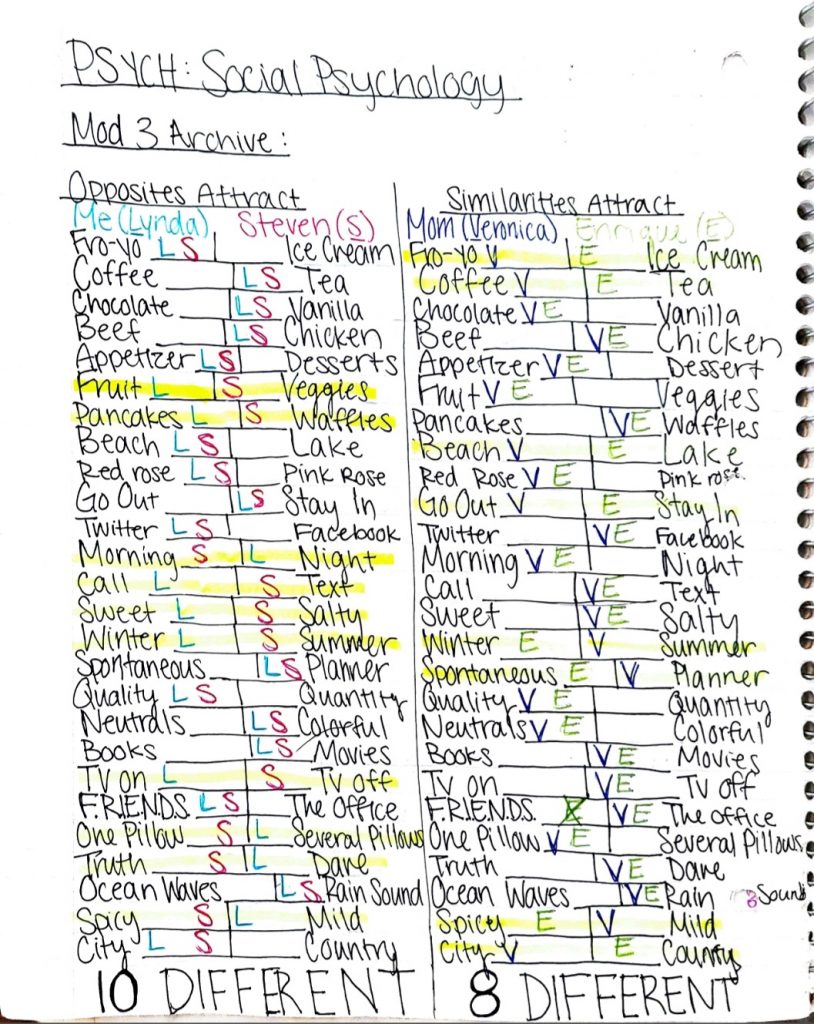
I chose module 3 archive 1 as my #1 top artifact. I chose this as number one because it was the very first assigned archive we had to do and it was the first assignment where I included a representative image, and I feel that including images in my work has helped me to be able to back up the information I am presenting since I am providing a visual. This represents what I have learned because this was the first step and since then I think I have progressed and been able to easily find a visual to go along with my work.
Top Artifact #2
Attitude Survey
Please indicate your degree of agreement or disagreement with each of the following statements:
1. Students will speak out more during a lecture if they have read the assigned reading.
1 2 3 4
disagree agree
2. Wearing a seatbelt significantly reduces the chance of suffering a serious injury in a car accident.
1 2 3 4
disagree agree
3. Homelessness is a serious social problem that needs attention.
1 2 3 4
disagree agree
4. Engaging in regular physical exercise several times a week promotes good health.
1 2 3 4
disagree agree
5. Recycling is a great way to protect the environment.
1 2 3 4
disagree agree
6. Designating a non-drinking driver can reduce the chance of being in an alcohol-related accident.
1 2 3 4
disagree agree
Behavior Survey
Please indicate with a yes or no whether you do the following behaviors:
_No_1. I always read the assigned materials before class.
_Yes_2. I regularly use a seatbelt to prevent my chances of suffering major injuries.
_Yes_3. Within the past year, I have personally done something to address the problem of homelessness.
_No_4. I take time to engage in regular physical exercise several times a week.
_No_5. I habitually recycle to protect the environment.
_No_6. I regularly designate a non-drinking driver before traveling to bars.
Response
I feel that my answers to the two surveys were fairly inconsistent and almost ironic. I think recycling is important, yet I don’t make the extra effort to do it consistently. The cognitive dissonance makes me feel somewhat ashamed because it is something that is important to me and will benefit countless others if I do my part. It makes me feel like I’m not proving I care enough when I know I do and I make an effort when I can.
We often feel the need to reduce the inconsistency between our attitude and behavior to make better sense of the situation and feel more content. An ongoing situation I am in that is a great example of cognitive dissonance is between my grandma and me. As we all know, it is the time of the coronavirus and, like many others, I have been scared to travel, but mandates have been lifted and I know eventually I will have to adjust back to the old “normal life.” I am still very wary about not wearing a face mask anymore, but that is beside the point. My grandma has been asking me to visit her for almost a year, and I miss her so much and want to see her, but I keep canceling my flights or pushing back when I will actually go to visit her. It makes me feel pretty bad that I keep doing this, but I am not as comfortable with going on planes like I used to be. It’s not the same world anymore, so much has changed. And I suppose that would be my excuse for waiting so long, but I know I will regret not visiting her this summer if I keep pushing back the dates, so I have decided I will see her either in July or August of 2021. And as long as my fear doesn’t become my reality, then it will all be worth it.
I chose module 7 archive 5 as my #2 top artifact because it gave me a realization about the controversial things that I do and it taught me about myself. It was very interesting for me to finally be able to put into words what I feel and why I constantly do things that don’t give me consistency. It represents what I learned because I have been working on myself since starting this assignment.
Top Artifact #3
Are People Who Help Happier?
Person Happiness Selfishness
- __LJ__ __UH__ __S__
- ___SD__ __H___ ___S__
- __VS___ ___H__ ___S__
- ___LJ__ __H___ ___S__
- __EV___ __H___ ___US__
- __EU___ __UH___ __S___
- __BL___ __UH___ ___S__
- __CH___ __H___ ___US__
- __KD___ ___H__ __US___
- __JD___ ___UH__ ___US__
| Happy | Unhappy | |
| Selfish | 3 | 3 |
| Unselfish | 3 | 1 |
Takeaway:
Based on my frequency calculation each pairing was tied for the greatest tally except for the unselfish/unhappy category. I think most people do not typically associate selfishness and happiness together because people who are happy are usually more generous, and those who are selfish are usually unhappy because they are less genuine and don’t care for others as much as the average happy person does. Happy people will go out of their way because they want to spread positivity. An unhappy, selfish person will do what is in their best interest no matter who they have to tear down to get there.
Visual artifact:
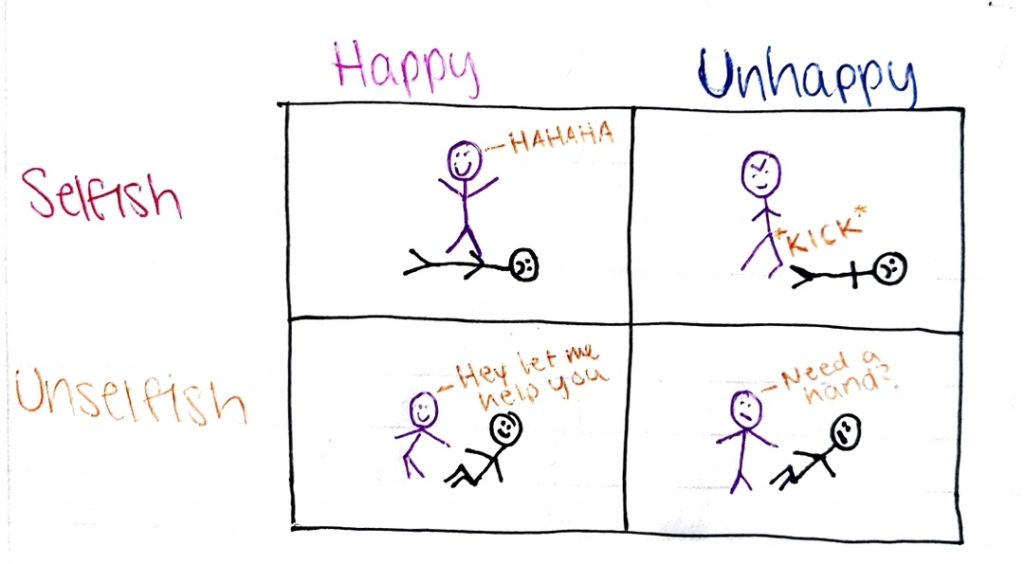
I chose module 11 archive 9 as my top artifact #3. I chose this one because it was an interesting assignment and it was very interesting seeing where I fell in the pairings. This artifact represents what I learned because I learned about how people can defy the norm and still fall under categories that I wouldn’t normally think they belonged to. It is very similar to one of the first assignments we had this semester where we discussed stereotypes.
Top Artifact #4
Subjective Happiness Scale (SHS)
- In general, I consider myself:
1 2 3 4 5 6 7
not a very happy person a very happy person
- Compared to most of my peers, I consider myself:
1 2 3 4 5 6 7
less happy more happy
- Some people are generally very happy. They enjoy life regardless of what is going on, getting the most out of everything. To what extent does this characterization describe you?
1 2 3 4 5 6 7
not at all very much
- Some people are generally not very happy. Although they are not depressed, they never seem as happy as they might be. To what extent does this characterization describe you?
1 2 3 4 5 6 7
not at all very much
Takeaway:
Happiness is one of the best feelings to experience and one of my favorite things to spread to other people. To me, happiness is that warm feeling you get that comes with a sensation of peace and positivity. The SHS is a brief quiz that is mean to judge your subjective level of happiness. The average happiness score is typically about 4.5 to 5.5. College students, like myself, tend to score lower than working adults and older, retired people. I scored a 3.0 on the SHS. Compared to the average score for men and women regardless of age and occupation, I scored much lower than everyone else. I do not necessarily think the SHS is inaccurate because I feel that my score fits me well, but I do think there are better ways to measure the true levels of someone’s happiness. For starters, the quiz could be longer and more detailed, or even completely changing the quiz to just a questionnaire. Cultural expectations influence people’s perception of happiness by having standards, but these standards do not always apply to everyone which is why there can be happy people who do not get scores they feel suits them.
Visual artifact:
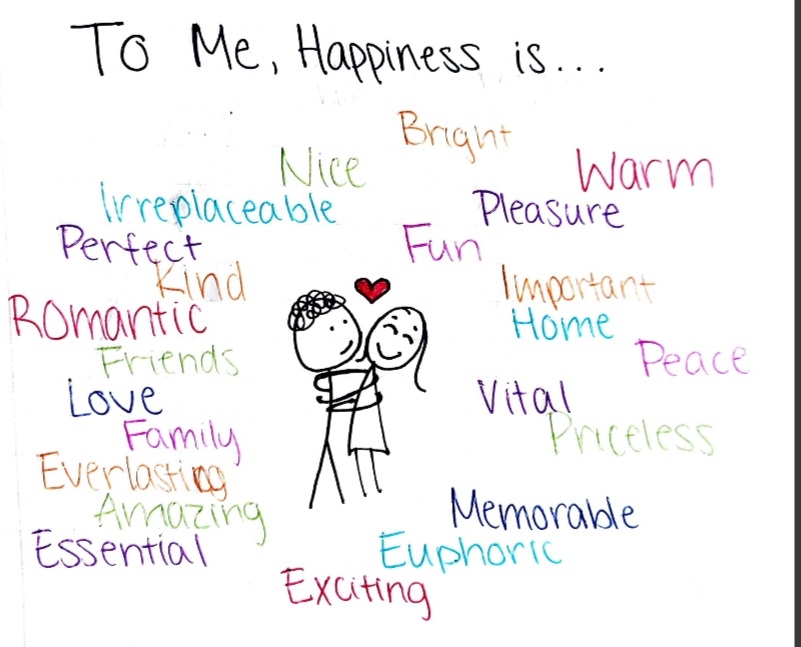
I chose module 14 archive 12 as my top artifact #4 because it was one of my favorite assignments. I enjoyed defining happiness especially because I have been struggling with my own. The assignment had me thinking about how I truly feel and it was neat seeing how I compare to other people. This represents what I have learned because I have come a long way to understand my emotions and where I stand in terms of my happiness and it was a fun assignment.
Top Artifact #5
Yes, reporting acts of terrorism leads to a distorted perception of the views of the average resident of the terrorists’ home country. Social Media and the media, in general, are notorious for taking information and running with it regardless of the facts. People like to stereotype others and put them into categories they don’t always fall into. This puts all of the people categorized into more danger because people who believe everything they hear get these outrageous ideas that they need to do something drastic to “save themselves.” Going back to terrorism and distorted perceptions of a terrorist’s home country makes it much more unsafe for everyone who comes from that country. Just like when the coronavirus was first being talked about in the news, so many Americans and other nationalities were incredibly racist and hating on Chinese and Asian Americans because they thought they were all who brought the virus to North America.
The media plays a huge role in what people hear, think, and believe. In the video, ”Are We Scaring Ourselves to Death?”, the narrator explains that citizens feared that locations and particles in the air caused cancer, but by the time studies were able to confirm this was not actually the case, it was too late. The information wasn’t broadcasted as much as it should have been because everyone had moved on to the next thing to be afraid of. People fear what they do not know or understand. They are comfortable with the things they know and are used to. If the media were to present accurate information regarding things people fear such as mortality, there wouldn’t be so much fear because people would be educated on topics that concern them.
Visual artifact:
The following images are screenshots from the youtube video titled Are We Scaring Ourselves to Death? Found at https://www.youtube.com/watch?v=WmiFShBQDIs. I chose to include these ones specifically because of the relevance to the topic and to show what people fear v. what they should fear.

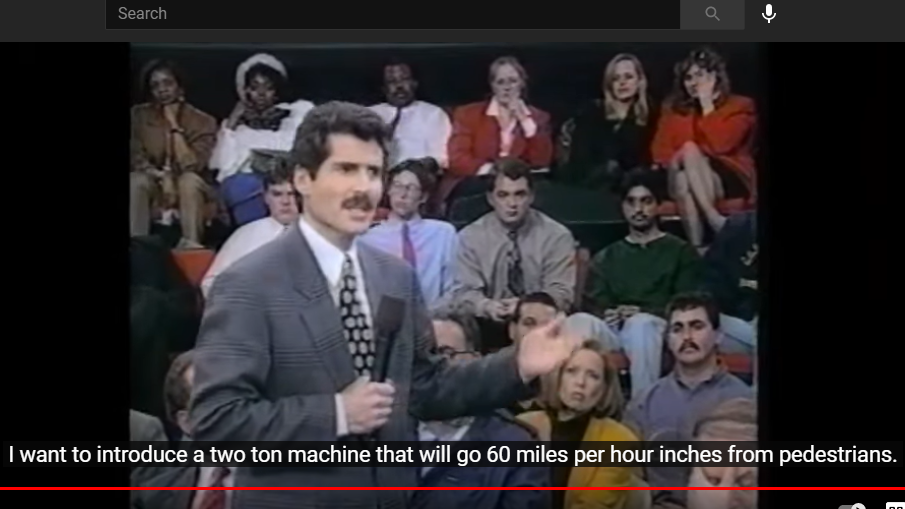
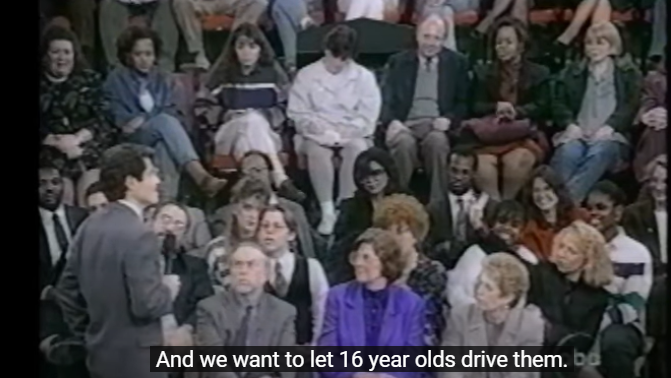
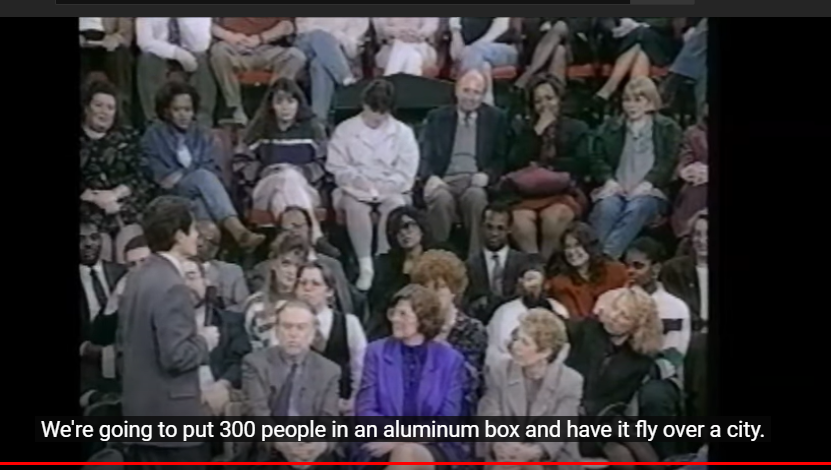
I chose module 4 archive 2 as my top artifact #5 because of the assignment. I found the video attached to be quite interesting. I have never had so many assigned videos grab my attention the way the videos in this class have. It represents what I have learned because I learned how big of an influence the media has on people especially when it comes to fears and what people should be wary of.